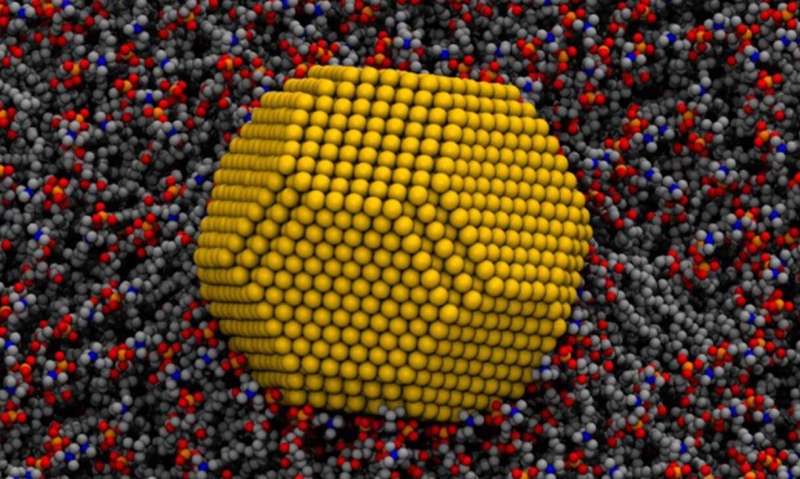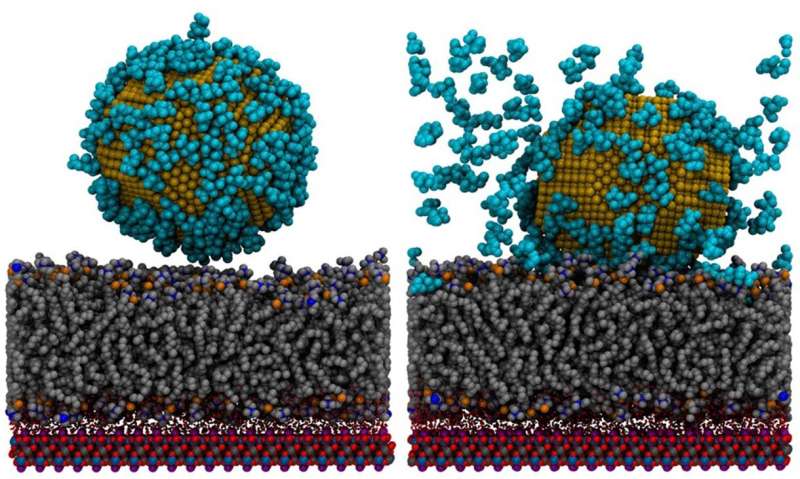Potential of nanomedicine to cure conditions that are currently incurable

Scientists at RMIT University say their new research advances the potential of nanomedicine to cure conditions that are currently incurable, such as dementia and motor neuron disease.
Their work explores how nanoparticles would interact with cells in humans and provides fundamental knowledge to help improve nanomedicine and develop the next generation of personalized biomedical technologies.
Nanoparticles open the door to technologies that could improve treatments and disease diagnosis for patients, according to the scientists.
One of the lead researchers, Dr. Aaron Elbourne, said nanoparticle technologies could ultimately improve drug delivery, cancer treatments, disease diagnostics and antimicrobials.
"Nanoparticles have been investigated as advanced nanomedicines, but they often miss the mark or fail to deliver their treatment to a specific location within the body," said Elbourne, from the School of Science.
"The main challenge is to control how nanoparticles engage with cells to accurately deliver the medicine. This has been poorly understood until now, but our latest work offers a clearer picture of what is happening at that nano level."
Helping to design better nanomedicines and diagnostic nanoparticles
Most nanoparticle technologies need to pass through a cell's outer membrane to fulfill their function, Elbourne said.
"This membrane serves as an important protective barrier that isolates the internal cell environment from the surroundings, but it also poses a challenge for the delivery of nanoparticles."
Elbourne said if scientists could overcome this challenge, it would potentially open a new era of medicine.
The latest study, led by RMIT in collaboration with the University of Durham and published in the ACS Nano journal, tackles this problem by providing scientists a pathway to design more effective nanomedicines and diagnostic nanoparticles.

How they conducted the research
Using atomic force microscopy along with computer simulations of molecular activity, the team discovered the precise mechanisms by which gold nanoparticles—a tiny fraction of the width of a human hair—interact with artificial cell membranes.
Fellow RMIT lead researcher, Dr. Andrew Christofferson, said their work was unique.
"What makes this work unique is that we combine experiments and modeling to show a level of detail not seen before, and this will serve as a platform for future studies of nanoparticles and biological materials."
The potential to treat currently untreatable brain diseases
The team says one of the main barriers to finding a cure for diseases such as dementia and motor neuron disease is the current inability to deliver treatments that can cross the blood-brain barrier, a membrane that blocks foreign entities reaching the brain.
First author and Ph.D. researcher, Rashad Kariuki, was excited to work with nanoparticles that would be small enough to pass through this membrane.
"We currently have limited treatments that can pass through the blood-brain barrier because many are just too big or don't interact favorably with this particular membrane," he said.
"If we could use nanoparticles to treat brain diseases non-invasively, that would be a gamechanger."
More work needs to be done before nanoparticles reach their full potential to help treat diseases but new wound treatments using this technology are in development, Elbourne said.
"We have collaborators at the University of South Australia that we're working with on treatments for chronic and acute wounds," Elbourne said.
"Ultimately, our work could positively impact a wide range of treatments, meaning better outcomes for patients and health systems."
"Behavior of Citrate-Capped Ultrasmall Gold Nanoparticles on a Supported Lipid Bilayer Interface at Atomic Resolution" is published in ACS Nano.
More information: Rashad Kariuki et al, Behavior of Citrate-Capped Ultrasmall Gold Nanoparticles on a Supported Lipid Bilayer Interface at Atomic Resolution, ACS Nano (2022). DOI: 10.1021/acsnano.2c07751
Journal information: ACS Nano
Provided by RMIT University





















